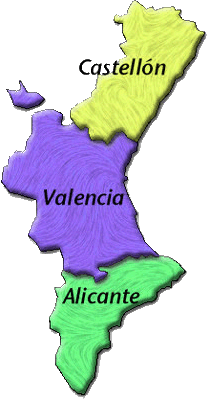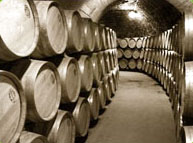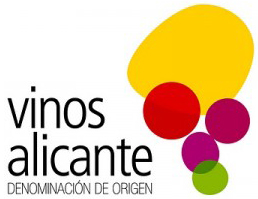Valencia DOs (Part I)

The Valencian Community (which is known as the Comunidad Valenciana in Spanish, and the Comunitat Valenciana in Valencian) is a Spanish autonomous community which can be found along the east coast of Spain. It borders with the Mediterranean sea in the east, Murcia in the south, Castile la Mancha in the west, Aragon in the northwest and Catalonia in the north.
The tradition of Valencia wines can be traces as far back as the Phoenicians, who introduced the vines in this area between 1.200 a. C and 146 a. C. The Iberians also loved wine and produced it regularly, as did the Greeks, who introduced the "generous wines" in the Spanish wine culture. In the 2nd century the Romans arrived in Spain (they called it Hispania) and spread their wine culture throughout the Spanish Mediterranean coast: Tarraco (Tarragona, which is close to Barcelona), Saguntum (Sagunto) and Dianion (Denia). In Valencia, the arrival of the Muslims didn't end the production of wine, even though it was strictly prohibited by the Quranic laws. In fact, the Muslims grew vines for the fruit, which they ate ripe or dried into raisins.
The Middle Ages brought regulations regarding wine trading. Greek wines were imported during this time; they were normally quite thick and sweet, almost like a syrup, and frequently mixed with the native Valencia wines. This mix was highly considered and exported, mainly throughout Mediterranean ports. Wine was also quite important for the medicine advances because of the antiseptic qualities of the alcohol, so it was often mixed with water to get rid of its impurities.

At the arrival of the 15th century Valencia wines had acquired quite a fame, specially "Fondillón" wine, which was produced in Alicante. For this reason it was very common to see international boats anchored in the port of Alicante, waiting fortheir fondillón shipment to take back home. In fact, these wines were so coveted that producers started mixing it with other wines and selling it as fondillón, but this was stopped by Fernidand II of Aragon (the Catholic Monarch) when he banned the import of other wines into Alicante, so as to preserve the quality of these Valencia wines.
Up until the end of the 17th century, wines were drunk in the year they were produced, and as the harvest approached, the price of the "old" wines descended. During this century a new social class appeared in France and England, a new social class that had enough money to be willing to pay a fair quantity for good wines. Thus, the production process of wine changed, and every step in the process was done with all the necessary care so as to produce wines that these rich gentlemen were happy to pay the elevated price for.
When the phylloxera destroyed the vineyards in France during the 18th-19th century, the French turned to Spain in search of wines. The vineyards producing Valencia wine began expanding, and at one point the ports of Alicante and Valencia exported around 40% of the total production of wine in Spain. Fortunately, when the plague arrived in Spain the phylloxera remedy had been discovered and Spain was able to salvage many of its vineyards. The rest were replanted with foreign and more sturdy vines.
The first regulations, which set the foundations for the future DOs of Spain, came from a necessity to manage the production of wines and to fight against fakes. The 80s were specially good for the Valencia wines and the Spanish wines in general, as the production went up and the wines started to be known outside Spanish borders, thus also helping the wine tourism industry.
DOs (designations of origin) in the Valencian Community
There are three different designations of origin in Valencia, and each produces different types of wine. The warm climate in Valencia helps with the ripening of the grapes, and its common for the harvest to be done earlier than in other DOs. The higher insolation received by the fruits which produce Valencia wines means that their sugar content is normally higher than in other wines. From this area, the Mistela or Moscatel Liquor wine is pretty popular, and still today it's produced following traditional methods.
DO Alicante

D0 Alicante was established in 1957. This DO has two areas of wine production: La Marina is on the eastern part of Alicante, on the shore of the Mediterranean; Vinalopó is further inside, bordering with Castile la Mancha and Murcia. The Valencia wines produced by DO Alicante are mostly reds, but they're better known for the production of traditional sweet wines, which have been present in the Mediterranean cuisine for centuries.
DO Alicante is also widely known for its Fondillón wine. This wine is produced 100% with Monastrell grapes, and it's very sweet. However, unlike fortified wines, the sugar in Fondillón comes from the over ripening of the fruit, not from later addition. The main grape varieties used are Moscatel, Garnacha Tintorera and Monastrel.
There are two other designations of origin in Valencia: DO Utiel-Requena and DO Valencia, which you can read about on on second page concerning the wines of Valencia.
Spanish Wine History
Spanish Wine Regions and DO
Spanish Wine Tours
Top Spanish designations of origin
Best Spanish Wines
Spanish Wine Production
Spanish Wine Types
Spanish Grapes
Spanish Sparkling Wine: Cava
Sherry Wine
Spanish Wine Cocktails
Spanish Wines in the World
Spanish Wine Prizes
Enotourism
Spanish spirits and liquors
Argentina Wines
Chilean Wines
Other sites